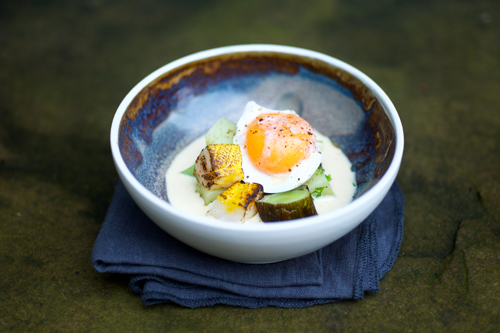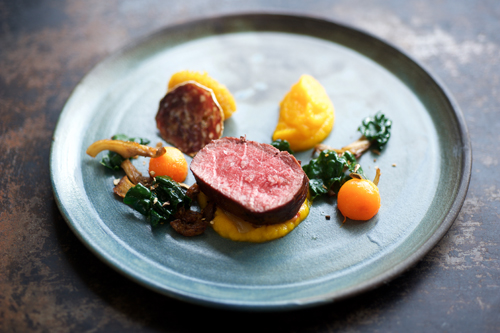What's in season: January
Fresh produce supplier James Wellock suggests some great produce to delight your customers after the Christmas festivities, while consultant chef Madalene Bonvini-Hamel shares some of her favourite seasonal recipes
January can feel like a bit of a come-down in the kitchen after the busy festive period, but some stunning produce starts to appear this month that will get your creative juices flowing, as well as help your gross profit over the quieter period
For me, this is the best time of the year for citrus fruit. Blood orange is the finest dessert orange in the world; it needs the cooler nights to develop the sensational bright maroon flesh, which is also the healthy part, as its anthocyanin pigments are antioxidants. Blood orange has double the amount of vitamin C of an ordinary orange, and 30% of your daily dietary fibre. It also has a unique and distinct raspberry flavour and the juice just pours out.
Pears are the queen of the season and the Passe-Crassane pear is at its juicy best in January. The only thing I can say is serve it with a bib!
There's no shortage of options on the apple front either. Look out for gems like the GoldÂrush, Chantecler, Patte de Loup, Grey Pippin, and the Clocharde. For cooking, the French use the Patte de Loupe. These can be eaten raw and you will certainly not have to add sugar when cooking them, so they are a much healthier dessert option.
For exotic perfumes and flavours, there's mangosteen, lychees, mango and melon from Brazil and Senegal, and the highly perfumed French Muscat grape.
Closer to home, this is the month for early Yorkshire forced rhubarb - a burst of colour in a predominantly grey month. Enjoy the stunning, bright red stems, lovely yellow leaves and meltingly sweet and tender flavour and texture.
For the ultimate luxury, there are black Périgord truffles, which are now at their best as the frost helps to ripen them and intensifies their flavour. Our black diamonds come from a secret supplier in Spain, where they are currently cultivating the best truffles in the world - so good that truffle hunters from France and Italy are buying there rather than at home.
If truffles are off the budget, you can add richness to winter dishes with dry products, like nuts and beans. The Tarbais haricot bean is full of flavour and very tender, and flageolet beans and Puy lentils are other good choices.
GP-boosting winter vegetables are again in abundance in January. One winner is the Jerusalem artichoke, with the Lincolnshire product taking precedence over the French, not only in flavour but also in price. At around £1 to £1.20 per kilo, it makes a flavoursome and comforting soup of the day paired with haricot beans and a splash of truffle oil - or in a gratin as a luxury side. French Muscade pumpkins will also be down to around £1 a kilo - a steal for soups, roasting and pasta.
Purple sprouting broccoli is also becoming a staple as local growers develop more weather-resistant varieties - plus, there's little prep and no waste.
This is a great month for cabbages as the frost makes them milder and sweeter. The cabbage used to be the basis of winter dishes in Britain before the potato, which originated in South America, came into large-scale cultivation in the 1700s. Cabbage comes in a wide range of textures, colours and flavours and has all the vitamins we need to beat the cold. It's locally grown, and the best for me is January King - streaked with red and bursting with flavour. It's a great price, as are the excellent red and white Savoy cabbages now in abundance.
White chicory is in season, along with the forced dandelion; even though you can find them all year round, they taste best between now and March.
Chervil root is also becoming more popular. Nutty and subtly sweet, it has a flavour reminiscent of sweet carrot, with subtle hints of celeriac and a creamy white interior. It's delicious boiled and then finished in a hot pan with butter or puréed.
Parsley root looks very similar to parsnip but has a more delicate flavour. The taste is sweet, but also sharp and bitter - somewhere between a celeriac and carrot, with hints of parsley leaf and turnip.
Other great-value winter winners are small graded English onions - red and brown - perfect for roasting whole along with baby parsnips. Root veg such as celeriac, swede and turnip is generally at its best this season, and carrots cropped during the winter are unforgettable. Try the popular Chantenay, now available as a rainbow of roots in purple, yellow, orange and white. Fan these beauties across any plate for a stunning effect. It's sure to brighten up the gloomiest of winter days.
Smoked haddock, soft boiled hen's egg, burnt leeks and smoked haddock velouté
Serves 8
For the smoked haddock velouté
- 1tbs unsalted butter
- 2tsp rapeseed oil
- 250g smoked haddock, trimmed and roughly diced
- 100g leeks sliced
- 100g celery, diced
- 100g banana shallots, finely sliced
- 2 garlic cloves, crushed
- 2 large sprigs of thyme
- ½tsp coriander seeds
- ½tsp fennel seeds
- 125ml dry vermouth
- 1l fish stock
- 250ml double cream
- Sea salt and freshly cracked black pepper
For the garnish
- 2 large leeks
- 2 large Désirée potatoes, peeled and cut into 1cm dice
- 1tsp fresh continental parsley, shredded
- 8 hens' eggs
- 288g skinless smoked haddock, cut into 12g cubes
- 1tbs cold pressed rapeseed oil
- Sea salt and freshly cracked black pepper
First, prepare the velouté. Heat a large saucepan over a medium heat with the rapeseed oil and butter. Add the smoked haddock, leeks, celery, shallots, garlic, thyme, coriander seeds and fennel and lightly season with salt and pepper. Sauté for seven to eight minutes, stirring regularly, until the vegetables start to colour.
Deglaze the saucepan with the vermouth, increase the heat and boil rapidly until it is reduced by two-thirds. Add the stock and bring the velouté back to a gentle simmer. Reduce the heat and simmer for 10 to 15 minutes until the stock is reduced by half. Add the cream and simmer for a further eight minutes, until the velouté lightly coats the back of a metal spoon.
Pass the velouté through a fine sieve, taste and adjust the seasoning if needed, and set aside while preparing the rest of the dish.
In the meantime, prepare the leeks. Burn the outer layer of the leeks on a barbecue or in a Josper-style oven, and then place on a lined baking tray in a preheated oven at 200°C for 15 minutes. When cooked, place the leeks in a tray, cover with clingfilm and set aside to steam while preparing the rest of the dish.
Cook the diced potatoes in salted water until cooked and tender. Drain and season lightly with salt and pepper, add the shredded parsley and keep warm. In a separate saucepan, boil the eggs for six minutes.
Prepare the smoked haddock and toss in a bowl with the oil to lightly coat the fish. Lay the fish cubes on a metal tray and cook under a preheated grill on high temperature for two minutes until golden-coloured and warm all the way through.
To serve, spoon the warm potatoes and cooked smoked haddock into warm soup bowls. Cut the leeks into slices half a centimetre thick and arrange three slices per portion. Peel the eggs, and rip the white off the top of each egg to reveal the yolk. Season the egg with salt and pepper and place on top of the potatoes and smoked haddock. Pour the boiling hot velouté in a sauce jug and serve immediately.
Venison loin with butternut squash and mushrooms
Serves 8
For the butternut squash jam
- 50g onion, peeled and quartered
- 1 large fresh red chilli, deseeded
- 50g fresh root ginger, peeled
- 2 cloves garlic
- 200g butternut squash flesh, diced
- 1 cooking apple, peeled, cored and diced
- 200g caster sugar
- 200ml white wine vinegar
- 1 cinnamon stick
- 1 star anise
- Sea salt and freshly cracked black pepper
For the venison loin
- 2 venison loins, about 300g each
- 2tbs unsalted butter
- 1 garlic clove
- 1 large sprig of fresh thyme
- Sea salt and freshly cracked black pepper
For the butternut squash garnish
- 1 butternut squash, peeled and seeds removed
- 2tbs unsalted butter
- 1tbs rapeseed oil
- Sea salt and freshly cracked black pepper
To serve
250g oyster mushrooms, shredded
- 2tbs unsalted butter
- Sea salt and freshly cracked black pepper
- 200g cavolo nero, shredded
- 8 thin slices of venison salami
First, prepare the butternut squash jam. Place the prepared onion, chilli, ginger, garlic, butternut and apple in a Thermomix jug and pulse-blend for 30 seconds, scraping the sides down and repeating the process until the mixture becomes finely chopped but not puréed.
In a medium saucepan, dissolve the sugar in the vinegar with the spices over a low heat. Stir until dissolved and then increase the heat and add the chopped mixture with seasoning. Bring to a gentle simmer, stirring occasionally, and cook for about 20 minutes until the jam is cooked and the mixture becomes thickened and glossy. Transfer to a container and leave to cool completely. The jam can be made and kept in sterilised jars for up to two weeks in advance.
Prepare the venison. Trim the venison loins, removing the silver skin, and shape them into barrels of even shape and thickness. Wrap them tightly in clingfilm, place in vacuum bags and seal on hard vacuum. Cook in a preheated water bath at 54°C for 30 minutes.
In the meantime, prepare the butternut squash garnish. Use a parisienne scoop to extract medium-sized balls from the peeled butternut squash - you need two per portion. Toss the butternut squash balls in the oil with seasoning and spread on a lined baking tray. Cover them with foil and cook in a preheated oven at 180°C for about 20 minutes until cooked but still keeping their shape and then keep them warm.
Chop up the butternut squash trimmings very small, and then place in a medium saucepan with the butter and seasoning. Cook over a medium heat with a lid until completely soft and cooked; blend to a smooth purée and keep warm.
Heat two non-stick frying pans over a medium heat. In one pan, sauté the mushrooms with seasoning in the butter until golden brown and cooked and then drain on kitchen paper; keep warm.
Once the venison is cooked, remove it from the bags, take off the clingfilm and drain on kitchen paper. In the other frying pan, brown the venison in the remaining butter with the garlic, thyme and seasoning until golden brown all over. Rest the meat for about three minutes.
Bring a medium saucepan with salted water to the boil and cook the cavolo nero; drain and season.
To serve, arrange a quenelle of the butternut squash jam onto the warm serving plates, and place one slice of the venison salami on each plate. Place a spoonful of the warm butternut purée with cavolo nero, cooked mushrooms and the butternut squash balls on each plate.
Carve the venison into thick, even slices and season each slice with sea salt. Place a slice on each plate and serve.












